2018 School Spending Survey Report
Celebrating Black History: Real People and Real Lives
Dig into the past and explore the historical events, personal perspectives, and challenges and achievements that have contributed to the black experience in the United States with these recently published titles.
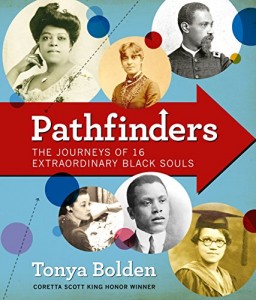 In Pathfinders: The Journeys of 16 Extraordinary Black Souls (Abrams, 2017; Gr 5-9), Tonya Bolden highlights the lives of inspiring individuals who dared to dream big, pursued their passions, and found innovative ways to succeed despite having the odds stacked against them. Chronically arranged chapters blend compellingly readable text with beautifully reproduced contemporary photos and facsimiles, timelines of important life events, and sidebars providing historical context, all arranged in a logical and eye-appealing format. The book begins with Venture Smith (c. 1727-1805), captured from his West African village as a boy and enslaved for decades, who purchased his own freedom as well as that of his family, became a landowner in Connecticut, and penned a memoire. Also included are Richard Potter (1783-1835), a magician who “wowed audiences with his hocus-pocus” from Canada to New Orleans; Mary Bowser (c. 1841-?), a spy for the Union during the Civil War; bank founder Maggie Lena Walker (1864-1934), who had no formal training but possessed an “aptitude for turning can’t into can”; Indiana speed racer and “matchless mechanic” Charlie Wiggins (1897-1979); architect Paul R. Williams (1894-1980), who preservered despite a high school teacher’s advice not to, and built a storied career; and mathematician Katherine Coleman Goble Johnson (1918- ), a “human computer” who was instrumental in charting courses and calculating trajectories for NASA space missions throughout a “long and stellar career” (she was one of the subjects featured in the 2016 bio-drama, Hidden Figures). Covering a wide variety of life paths and passions and many years of American history, this book will captivate readers and motivate them to “dream, reach, soar.”
In Pathfinders: The Journeys of 16 Extraordinary Black Souls (Abrams, 2017; Gr 5-9), Tonya Bolden highlights the lives of inspiring individuals who dared to dream big, pursued their passions, and found innovative ways to succeed despite having the odds stacked against them. Chronically arranged chapters blend compellingly readable text with beautifully reproduced contemporary photos and facsimiles, timelines of important life events, and sidebars providing historical context, all arranged in a logical and eye-appealing format. The book begins with Venture Smith (c. 1727-1805), captured from his West African village as a boy and enslaved for decades, who purchased his own freedom as well as that of his family, became a landowner in Connecticut, and penned a memoire. Also included are Richard Potter (1783-1835), a magician who “wowed audiences with his hocus-pocus” from Canada to New Orleans; Mary Bowser (c. 1841-?), a spy for the Union during the Civil War; bank founder Maggie Lena Walker (1864-1934), who had no formal training but possessed an “aptitude for turning can’t into can”; Indiana speed racer and “matchless mechanic” Charlie Wiggins (1897-1979); architect Paul R. Williams (1894-1980), who preservered despite a high school teacher’s advice not to, and built a storied career; and mathematician Katherine Coleman Goble Johnson (1918- ), a “human computer” who was instrumental in charting courses and calculating trajectories for NASA space missions throughout a “long and stellar career” (she was one of the subjects featured in the 2016 bio-drama, Hidden Figures). Covering a wide variety of life paths and passions and many years of American history, this book will captivate readers and motivate them to “dream, reach, soar.” 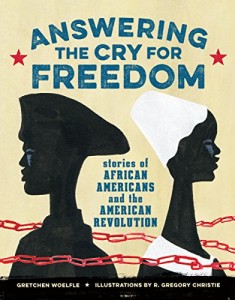 Gretchen Woelfle introduces 13 African American men and women who lived during the American Revolution and explains how they dedicated their lives to Answering the Cry for Freedom (Calkins Creek, 2016; Gr 4-9). The book is divided into thematic sections that invite readers to compare and contrast a variety of experiences. The first focuses on three soldiers: Boston King, an enslaved South Carolinian who joined the British army in hopes of gaining his liberty; Massachusetts freeman and Continental army enlistee Agrippa Hull; and enslaved Virginian James Armistead Lafayette, a spy for the Americans and the Marquis de Lafayette. The next section looks at individuals who lived in Massachusetts, the “Cradle of Liberty,” but still had to fight for their own natural rights: poet Phillis Wheatley, Elizabeth “Mumbet” Freeman, and social activist and Masonic Lodge founder Prince Hall. “Enslaved Women in the South” introduces Mary Perth, Ona Judge, and Sally Hemings, each of whom took a different route in pursuit of freedom. The last section highlights blacks who took the first steps along “the long road to equality”: wealthy ship-owner and abolitionist Paul Cuffee; John Kizell, who worked to end slavery in Africa; African Methodist Episcopal Church founding minister, Richard Allen; and church member Jarena Lee, who fought gender discrimination to become a preacher. Set clearly against historical events, these well-written vignettes make stirringly clear each individual’s motivations, the hard times and difficult choices he or she faced, and the significance of their accomplishments. Pull-out primary quotes and R. Gregory Christie’s elegant silhouettes grace the book’s pages, and notes, timelines, resources, and citations are appended, aiding further research.
Gretchen Woelfle introduces 13 African American men and women who lived during the American Revolution and explains how they dedicated their lives to Answering the Cry for Freedom (Calkins Creek, 2016; Gr 4-9). The book is divided into thematic sections that invite readers to compare and contrast a variety of experiences. The first focuses on three soldiers: Boston King, an enslaved South Carolinian who joined the British army in hopes of gaining his liberty; Massachusetts freeman and Continental army enlistee Agrippa Hull; and enslaved Virginian James Armistead Lafayette, a spy for the Americans and the Marquis de Lafayette. The next section looks at individuals who lived in Massachusetts, the “Cradle of Liberty,” but still had to fight for their own natural rights: poet Phillis Wheatley, Elizabeth “Mumbet” Freeman, and social activist and Masonic Lodge founder Prince Hall. “Enslaved Women in the South” introduces Mary Perth, Ona Judge, and Sally Hemings, each of whom took a different route in pursuit of freedom. The last section highlights blacks who took the first steps along “the long road to equality”: wealthy ship-owner and abolitionist Paul Cuffee; John Kizell, who worked to end slavery in Africa; African Methodist Episcopal Church founding minister, Richard Allen; and church member Jarena Lee, who fought gender discrimination to become a preacher. Set clearly against historical events, these well-written vignettes make stirringly clear each individual’s motivations, the hard times and difficult choices he or she faced, and the significance of their accomplishments. Pull-out primary quotes and R. Gregory Christie’s elegant silhouettes grace the book’s pages, and notes, timelines, resources, and citations are appended, aiding further research. 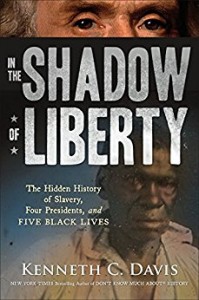 Similarly contrasting the fight for freedom and justice with the grim reality of human bondage, Kenneth C. Davis’s In the Shadow of Liberty (Holt, 2016; Gr 6 Up) sheds light on the lives of five enslaved individuals and the men who kept them in chains—four of our most-revered Founding Fathers and Presidents. Well-researched and absolutely gripping, the text delves into an area of history that has long been obscured, exploring the contradictions intrinsic to a nation “conceived in liberty” yet “born in shackles,” and revealing important truths and insights about America’s past. Throughout, the author skillfully weaves together primary quotes, statistics, and contemporary reproductions to relate mesmerizing biographical portraits set against vividly described historical backdrops. Introduced here are William “Billy” Lee, George Washington’s personal servant and constant companion, and the only slave freed at Washington’s death; Ona Judge, lady’s maid to Martha Washington, who courageously escaped her bondage during the first couple’s tenure in Philadelphia; Isaac Granger, born into slavery at Monticello in 1775, whose memories about life among “Mr. Jefferson’s People” were later collected and written down; Paul Jennings, enslaved servant of James Madison, who was at the White House when Dolley fled British invasion during the War of 1812; and Alfred Jackson, who grew up at Andrew Jackson’s Tennessee plantation, and lived there until his death in 1901, telling stories about Jackson to visitors after the Hermitage became a museum. This much-needed re-examination of American History is unflinching, fascinating, and illuminating. Dive into the Past
Similarly contrasting the fight for freedom and justice with the grim reality of human bondage, Kenneth C. Davis’s In the Shadow of Liberty (Holt, 2016; Gr 6 Up) sheds light on the lives of five enslaved individuals and the men who kept them in chains—four of our most-revered Founding Fathers and Presidents. Well-researched and absolutely gripping, the text delves into an area of history that has long been obscured, exploring the contradictions intrinsic to a nation “conceived in liberty” yet “born in shackles,” and revealing important truths and insights about America’s past. Throughout, the author skillfully weaves together primary quotes, statistics, and contemporary reproductions to relate mesmerizing biographical portraits set against vividly described historical backdrops. Introduced here are William “Billy” Lee, George Washington’s personal servant and constant companion, and the only slave freed at Washington’s death; Ona Judge, lady’s maid to Martha Washington, who courageously escaped her bondage during the first couple’s tenure in Philadelphia; Isaac Granger, born into slavery at Monticello in 1775, whose memories about life among “Mr. Jefferson’s People” were later collected and written down; Paul Jennings, enslaved servant of James Madison, who was at the White House when Dolley fled British invasion during the War of 1812; and Alfred Jackson, who grew up at Andrew Jackson’s Tennessee plantation, and lived there until his death in 1901, telling stories about Jackson to visitors after the Hermitage became a museum. This much-needed re-examination of American History is unflinching, fascinating, and illuminating. Dive into the Past 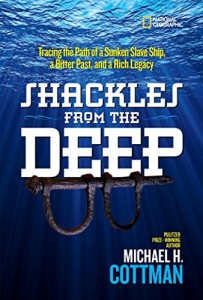 Michael H. Cottman’s absorbing Shackles from the Deep (National Geographic, 2016; Gr 6 Up) begins in 1972 with Captain “Moe” Molinar, a black underwater treasure hunter from Panama who was searching for the wreck of a gold-laden 17th-century Spanish galleon off the coast of Key West, Florida. Instead, in the sand, he discovered, “a pair of hardened, ancient shackles—heavy manacles the he knew were designed specifically to handcuff the wrists of enslaved Africans, wrists that—he couldn’t help thinking—had probably looked much like his own.” Looking further, he found another pair of shackles, tiny enough to sit in the palm of his hand, made to fit children. It would take years for marine archeologists to identify the source of these artifacts, an English slave ship called the Henrietta Marie that sunk in the early 1700s. When Cottman, an African American journalist and avid Scuba diver, was asked to chronicle the story of this ship in 1992, he embarked on a quest to research its origins and route—an emotional journey that took him from the historical tomes and captain’s logs located in England’s National Maritime Museum, to the Caribbean ports of call where enslaved Africans were sold at public auction and forced into backbreaking labor on sugar plantations, and all the way to House of Slaves on Senegal’s Gorée Island, now a museum and memorial. The author combines carefully conducted research, invaluable insights, and a page-turning adventure of investigation and discovery into a riveting book that is affectingly personal, emotionally harrowing, and historically impactful.
Michael H. Cottman’s absorbing Shackles from the Deep (National Geographic, 2016; Gr 6 Up) begins in 1972 with Captain “Moe” Molinar, a black underwater treasure hunter from Panama who was searching for the wreck of a gold-laden 17th-century Spanish galleon off the coast of Key West, Florida. Instead, in the sand, he discovered, “a pair of hardened, ancient shackles—heavy manacles the he knew were designed specifically to handcuff the wrists of enslaved Africans, wrists that—he couldn’t help thinking—had probably looked much like his own.” Looking further, he found another pair of shackles, tiny enough to sit in the palm of his hand, made to fit children. It would take years for marine archeologists to identify the source of these artifacts, an English slave ship called the Henrietta Marie that sunk in the early 1700s. When Cottman, an African American journalist and avid Scuba diver, was asked to chronicle the story of this ship in 1992, he embarked on a quest to research its origins and route—an emotional journey that took him from the historical tomes and captain’s logs located in England’s National Maritime Museum, to the Caribbean ports of call where enslaved Africans were sold at public auction and forced into backbreaking labor on sugar plantations, and all the way to House of Slaves on Senegal’s Gorée Island, now a museum and memorial. The author combines carefully conducted research, invaluable insights, and a page-turning adventure of investigation and discovery into a riveting book that is affectingly personal, emotionally harrowing, and historically impactful. 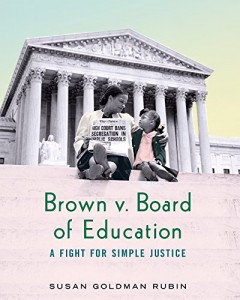 Susan Goldman Rubin’s Brown v. Board of Education: A Fight for Simple Justice (Holiday House, 2016; Gr 6-8) provides a very readable look at this 1954 landmark case, the history of school segregation, and the importance of social activism. An introduction provides background on Jim Crow laws, the 1896 Plessy v. Ferguson ruling that “established ‘separate but equal’ as the law of the land,” and the early career of Thurgood Marshall, legal counsel for the NAACP and champion of civil rights. Beginning with the family of Linda Brown and 12 other plaintiffs in Topeka, Kansas, chapters delve into all of the cases that were grouped together by the Supreme Court, tracing them from their local origins in four different states and the District of Columbia. Covered in depth are the careful and intelligent planning by the legal team, which also included African Americans Spottswood Robinson III and Robert L. Carter, as well as the effects of the proceedings upon the individuals involved, ordinary people who faced hostility, job loss, hate mail, and more. These personal stories, along with well-chosen quotes and contemporary photos (many starkly showing that in no way were schools for whites and blacks “separate but equal”), make history real and immediate. The final chapter offers an overview of the long and difficult road toward desegregation in public schools, a goal not yet achieved. Compelling and inspiring, this book informs while honoring those who faced hostility and danger in order to fight for justice.
Susan Goldman Rubin’s Brown v. Board of Education: A Fight for Simple Justice (Holiday House, 2016; Gr 6-8) provides a very readable look at this 1954 landmark case, the history of school segregation, and the importance of social activism. An introduction provides background on Jim Crow laws, the 1896 Plessy v. Ferguson ruling that “established ‘separate but equal’ as the law of the land,” and the early career of Thurgood Marshall, legal counsel for the NAACP and champion of civil rights. Beginning with the family of Linda Brown and 12 other plaintiffs in Topeka, Kansas, chapters delve into all of the cases that were grouped together by the Supreme Court, tracing them from their local origins in four different states and the District of Columbia. Covered in depth are the careful and intelligent planning by the legal team, which also included African Americans Spottswood Robinson III and Robert L. Carter, as well as the effects of the proceedings upon the individuals involved, ordinary people who faced hostility, job loss, hate mail, and more. These personal stories, along with well-chosen quotes and contemporary photos (many starkly showing that in no way were schools for whites and blacks “separate but equal”), make history real and immediate. The final chapter offers an overview of the long and difficult road toward desegregation in public schools, a goal not yet achieved. Compelling and inspiring, this book informs while honoring those who faced hostility and danger in order to fight for justice.  In How to Build a Museum (Viking/Smithsonian, 2016; Gr 5 Up), Tonya Bolden describes the planning, construction, and collections of the Smithsonian’s National Museum of African American History, which opened in Washington, DC, in September of 2016. This “hundred-year dream” is rooted in a 1915 reunion of Civil War soldiers. Tasked with establishing a monument honoring African American servicemen, the National Memorial Association soon expanded its objective and began campaigning for a museum devoted to black contributions in all areas of American life. Though a Congressional bill passed in 1929 to create a planning committee, it would be many contentious years before the project moved forward (the law establishing NMAAHC was signed by President George W. Bush in 2003). Describing everything from soup to nuts, the invitingly written chapters cover early development and the establishment of a vision (led by Director Lonnie G. Bunch III), the various ways that artifacts were acquired (including a “Treasures” program that invited people to bring family heirlooms to public institutions where they were viewed by experts who provided advice about preservation), and the architectural design and construction. Sprinkled throughout are crisp, carefully captioned images of artifacts, ranging from a Harriet Tubman’s shawl (a gift from Queen Victoria) to a biplane used by Tuskegee Airmen for training. The final section introduces readers to the 11 permanent exhibits, organized around themes of history, community, and culture. Throughout this handsome volume, the dynamic text and well-chosen reproductions emphasize the museum’s purpose of focusing more on people than events, and making all visitors feel, as Bunch suggests, “This is not a black story. This is my story. This is the American story.” Expand the reading experience by having your students explore the museum and its exhibits at the NMAAHC website (https://nmaahc.si.edu/). History Through a Different Lens: Narrative Poetry
In How to Build a Museum (Viking/Smithsonian, 2016; Gr 5 Up), Tonya Bolden describes the planning, construction, and collections of the Smithsonian’s National Museum of African American History, which opened in Washington, DC, in September of 2016. This “hundred-year dream” is rooted in a 1915 reunion of Civil War soldiers. Tasked with establishing a monument honoring African American servicemen, the National Memorial Association soon expanded its objective and began campaigning for a museum devoted to black contributions in all areas of American life. Though a Congressional bill passed in 1929 to create a planning committee, it would be many contentious years before the project moved forward (the law establishing NMAAHC was signed by President George W. Bush in 2003). Describing everything from soup to nuts, the invitingly written chapters cover early development and the establishment of a vision (led by Director Lonnie G. Bunch III), the various ways that artifacts were acquired (including a “Treasures” program that invited people to bring family heirlooms to public institutions where they were viewed by experts who provided advice about preservation), and the architectural design and construction. Sprinkled throughout are crisp, carefully captioned images of artifacts, ranging from a Harriet Tubman’s shawl (a gift from Queen Victoria) to a biplane used by Tuskegee Airmen for training. The final section introduces readers to the 11 permanent exhibits, organized around themes of history, community, and culture. Throughout this handsome volume, the dynamic text and well-chosen reproductions emphasize the museum’s purpose of focusing more on people than events, and making all visitors feel, as Bunch suggests, “This is not a black story. This is my story. This is the American story.” Expand the reading experience by having your students explore the museum and its exhibits at the NMAAHC website (https://nmaahc.si.edu/). History Through a Different Lens: Narrative Poetry 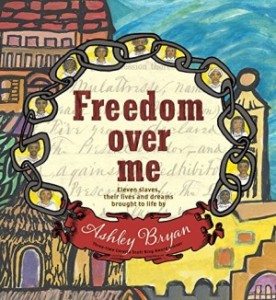 Blending evocative free verse and stunning watercolor artwork, Ashley Bryan’s Freedom Over Me (Atheneum/Caitlyn Dlouhy, 2016; Gr 4-8) brings to life 11 enslaved individuals. The opening poem sets the scene: after her husband’s death, Mrs. Mary Fairchilds chooses to sell the estate’s slaves and return home to England. (A reproduction of the 1828 appraisal of the Fairchilds estate—listing the first names and dollar values of 11 men, women, and children along with cattle and equipment—is appended, reminding readers that the cruel circumstances framing these portrayals are solidly based in fact.) From only these names and figures, Bryan imagines detailed daily existences, distinctive personalities, and resonant inner lives. Each individual is introduced with a stark portrait set against a backdrop collaged from historical deeds and other documents. A page turn provides a vibrant second image, awash with warm colors and exuberant motion, showing that person leading the life that he or she can only dream about. First-person poems touch upon each individual’s daily tasks and the talents that have made the plantation prosper, recollections of childhood and/or long-ago homes in Africa, the tight bonds and deep emotions that hold together this family of slaves, and an impossible-to-extinguish hope for freedom. The verse and images glow with the power of artistic creativity and self-expression, revealing a quiet sense of pride in accomplishment and breathtaking inner strength and resiliency. Both affecting and informative, compassionate and eye-opening, this beautifully wrought book vivifies America’s past and gives voice to those who had their very humanity stolen away.
Blending evocative free verse and stunning watercolor artwork, Ashley Bryan’s Freedom Over Me (Atheneum/Caitlyn Dlouhy, 2016; Gr 4-8) brings to life 11 enslaved individuals. The opening poem sets the scene: after her husband’s death, Mrs. Mary Fairchilds chooses to sell the estate’s slaves and return home to England. (A reproduction of the 1828 appraisal of the Fairchilds estate—listing the first names and dollar values of 11 men, women, and children along with cattle and equipment—is appended, reminding readers that the cruel circumstances framing these portrayals are solidly based in fact.) From only these names and figures, Bryan imagines detailed daily existences, distinctive personalities, and resonant inner lives. Each individual is introduced with a stark portrait set against a backdrop collaged from historical deeds and other documents. A page turn provides a vibrant second image, awash with warm colors and exuberant motion, showing that person leading the life that he or she can only dream about. First-person poems touch upon each individual’s daily tasks and the talents that have made the plantation prosper, recollections of childhood and/or long-ago homes in Africa, the tight bonds and deep emotions that hold together this family of slaves, and an impossible-to-extinguish hope for freedom. The verse and images glow with the power of artistic creativity and self-expression, revealing a quiet sense of pride in accomplishment and breathtaking inner strength and resiliency. Both affecting and informative, compassionate and eye-opening, this beautifully wrought book vivifies America’s past and gives voice to those who had their very humanity stolen away. 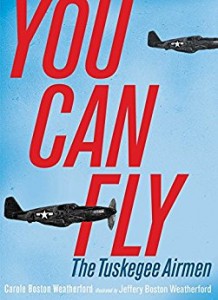 In You Can Fly: The Tuskegee Airmen (Atheneum, 2016; Gr 5 Up), Carole Boston Weatherford’s soaring verses prove that dreams cannot be grounded, despite impossible-seeming obstacles. Told from a second-person point of view that immediately puts readers into the cockpit, 33 poems trace the trajectory of the dedicated African American individuals who were determined to become pilots, from entry into the civilian training program at Alabama’s Tuskegee Institute to finally engaging the enemy in the skies above Europe. Packed with historical facts, the entries cover in detail the rigors, pressures, and prejudices faced by “The First Cadets” during aviation training (“The burden of past and future,/heavier than any aircraft./The eyes of your country are on you;/the hopes of your people/rest on your shoulders”); the joys of flying “Solo, At Last” (“You have never felt freer./Never”); the important work of African American support staff and Army nurses; the fight on the home front against racism and inequality; the distinguished service that earned the Tuskegee pilots the nickname, “Red Tail Angels;” and the reality these decorated soldiers faced upon returning home (“Your fight is by no means finished”). An epilogue reveals the far-reaching legacy of these pioneers (including full integration of the U.S. military in 1948), and an author’s note and timeline support the historical context. Jeffery Boston Weatherford’s scratchboard illustrations appear throughout, adding an appealing visual element to this compelling exploration of history.
In You Can Fly: The Tuskegee Airmen (Atheneum, 2016; Gr 5 Up), Carole Boston Weatherford’s soaring verses prove that dreams cannot be grounded, despite impossible-seeming obstacles. Told from a second-person point of view that immediately puts readers into the cockpit, 33 poems trace the trajectory of the dedicated African American individuals who were determined to become pilots, from entry into the civilian training program at Alabama’s Tuskegee Institute to finally engaging the enemy in the skies above Europe. Packed with historical facts, the entries cover in detail the rigors, pressures, and prejudices faced by “The First Cadets” during aviation training (“The burden of past and future,/heavier than any aircraft./The eyes of your country are on you;/the hopes of your people/rest on your shoulders”); the joys of flying “Solo, At Last” (“You have never felt freer./Never”); the important work of African American support staff and Army nurses; the fight on the home front against racism and inequality; the distinguished service that earned the Tuskegee pilots the nickname, “Red Tail Angels;” and the reality these decorated soldiers faced upon returning home (“Your fight is by no means finished”). An epilogue reveals the far-reaching legacy of these pioneers (including full integration of the U.S. military in 1948), and an author’s note and timeline support the historical context. Jeffery Boston Weatherford’s scratchboard illustrations appear throughout, adding an appealing visual element to this compelling exploration of history. 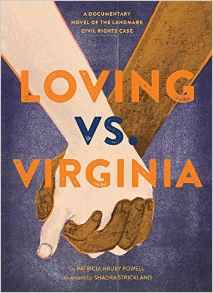 Written in vivid free verse, Patricia Hruby Powell’s Loving vs. Virginia (Chronicle, 2017; Gr 8 Up) presents an intimate and multifaceted look at the real-life individuals behind the landmark Supreme Court case that legalized interracial marriage. Beginning in the 1950s with their younger years, the two protagonists take turns describing how they met in their tight-knit Virginia community and fell in love. However, Virginia’s anti-miscegenation laws banning interracial marriage made it illegal for Mildred Jeter, who was considered “colored,” and Richard Loving, who was white, to wed. Married at a preacher’s house in Washington, DC, in June of 1958, they were arrested when they returned to Virginia, and served jail time. It would take nine long years of working with ACLU lawyers, living apart from the extended families that loved and supported them, and heartfelt courage and hope-filled determination before the unanimous 1967 Supreme Court ruling finally brought them joy and peace. Contemporary photographs, pull-out quotes and statistics, and reproductions of documents provide historical context and highlight civil rights milestones. Shadra Strickland’s lovely illustrations of the book’s subjects, designed to reference a 1950s style of visual journalism, enhance the narrative’s up-close-and personal mood and add to the emotional resonance. Filled with small, quietly eloquent moments and honest emotion (“Richard takes/my hand,/now we’re/strolling—/makes me feel like/I belong/right next to him”), this documentary novel brings the past to life. Whether incorporated into classroom studies, recommended for independent reading, or featured in library displays, these books make excellent resources to help students delve deeper into American History, gain greater insights into the experiences of African Americans, and perhaps contemplate the many ways that the past informs the present.
Written in vivid free verse, Patricia Hruby Powell’s Loving vs. Virginia (Chronicle, 2017; Gr 8 Up) presents an intimate and multifaceted look at the real-life individuals behind the landmark Supreme Court case that legalized interracial marriage. Beginning in the 1950s with their younger years, the two protagonists take turns describing how they met in their tight-knit Virginia community and fell in love. However, Virginia’s anti-miscegenation laws banning interracial marriage made it illegal for Mildred Jeter, who was considered “colored,” and Richard Loving, who was white, to wed. Married at a preacher’s house in Washington, DC, in June of 1958, they were arrested when they returned to Virginia, and served jail time. It would take nine long years of working with ACLU lawyers, living apart from the extended families that loved and supported them, and heartfelt courage and hope-filled determination before the unanimous 1967 Supreme Court ruling finally brought them joy and peace. Contemporary photographs, pull-out quotes and statistics, and reproductions of documents provide historical context and highlight civil rights milestones. Shadra Strickland’s lovely illustrations of the book’s subjects, designed to reference a 1950s style of visual journalism, enhance the narrative’s up-close-and personal mood and add to the emotional resonance. Filled with small, quietly eloquent moments and honest emotion (“Richard takes/my hand,/now we’re/strolling—/makes me feel like/I belong/right next to him”), this documentary novel brings the past to life. Whether incorporated into classroom studies, recommended for independent reading, or featured in library displays, these books make excellent resources to help students delve deeper into American History, gain greater insights into the experiences of African Americans, and perhaps contemplate the many ways that the past informs the present. RELATED
RECOMMENDED
CAREERS
The job outlook in 2030: Librarians will be in demand
CAREERS
The job outlook in 2030: Librarians will be in demand
ALREADY A SUBSCRIBER? LOG IN
We are currently offering this content for free. Sign up now to activate your personal profile, where you can save articles for future viewing






Add Comment :-
Comment Policy:
Comment should not be empty !!!
Margaret
Love to learn about new books to share with the students. I do integrated services in the library as a social worker and I couldn't find a more successful and resourceful place to service my students. The library is very engaging and full of SEL opportunities. Great books to add to our library collection.Posted : Mar 01, 2017 12:05